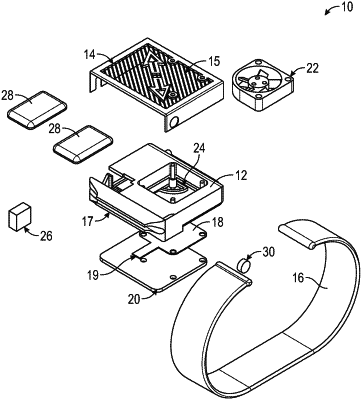| CPC F04D 25/084 (2013.01) [F04D 25/0673 (2013.01); A41D 13/0025 (2013.01); F04D 29/644 (2013.01); F16M 13/04 (2013.01)] | 22 Claims |

|
1. A wearable device, comprising:
a housing defining a reservoir for receipt of a liquid;
a forced air device positioned within the housing;
a thermally conductive element mounted with respect to the housing and positioned for thermal interface with the skin of a user, the thermally conductive element having a thermal conductivity of 50-425 watts/meter-Kelvin, at a temperature between 273° K and 300° K, which enables heat transfer away from the skin of the user for the user to feel a coolness from contact with the thermally conductive element;
a wetted media positioned within the housing, the wetted media (i) in fluid communication with liquid received by the reservoir, and (ii) in direct contact with the thermally conductive element for direct thermal communication with the thermally conductive element; and
means for detachably securing the housing relative to a user;
wherein the thermal conductivity of the thermally conductive element enables the thermally conductive element to cool down based on heat transfer to the wetted media, and
wherein operation of the forced air device effects evaporative cooling through liquid evaporation from the wetted media and, based on direct thermal communication between the wetted media and the thermally conductive element, effects cooling of the thermally conductive element positioned for thermal interface with the skin of the user.
|